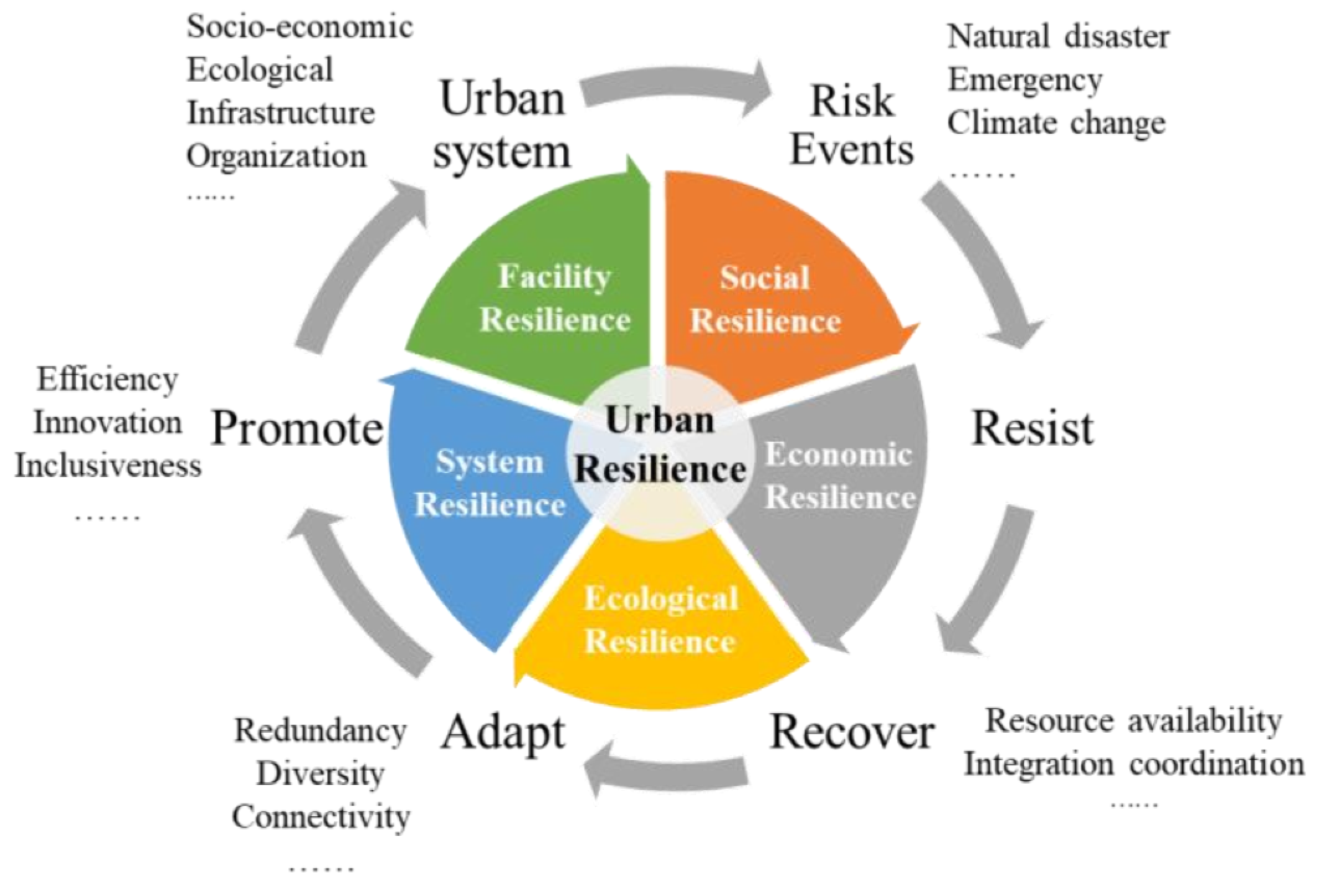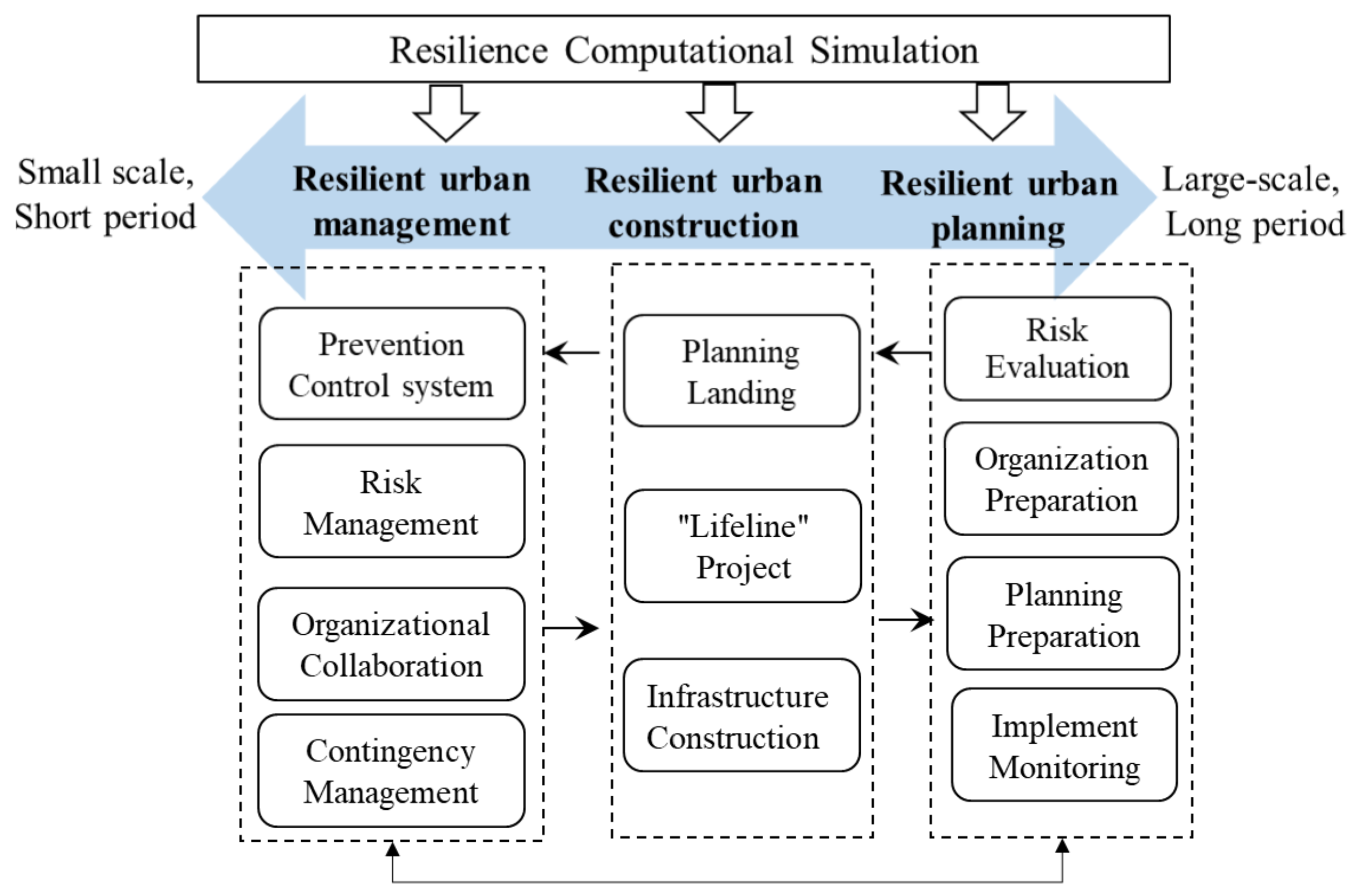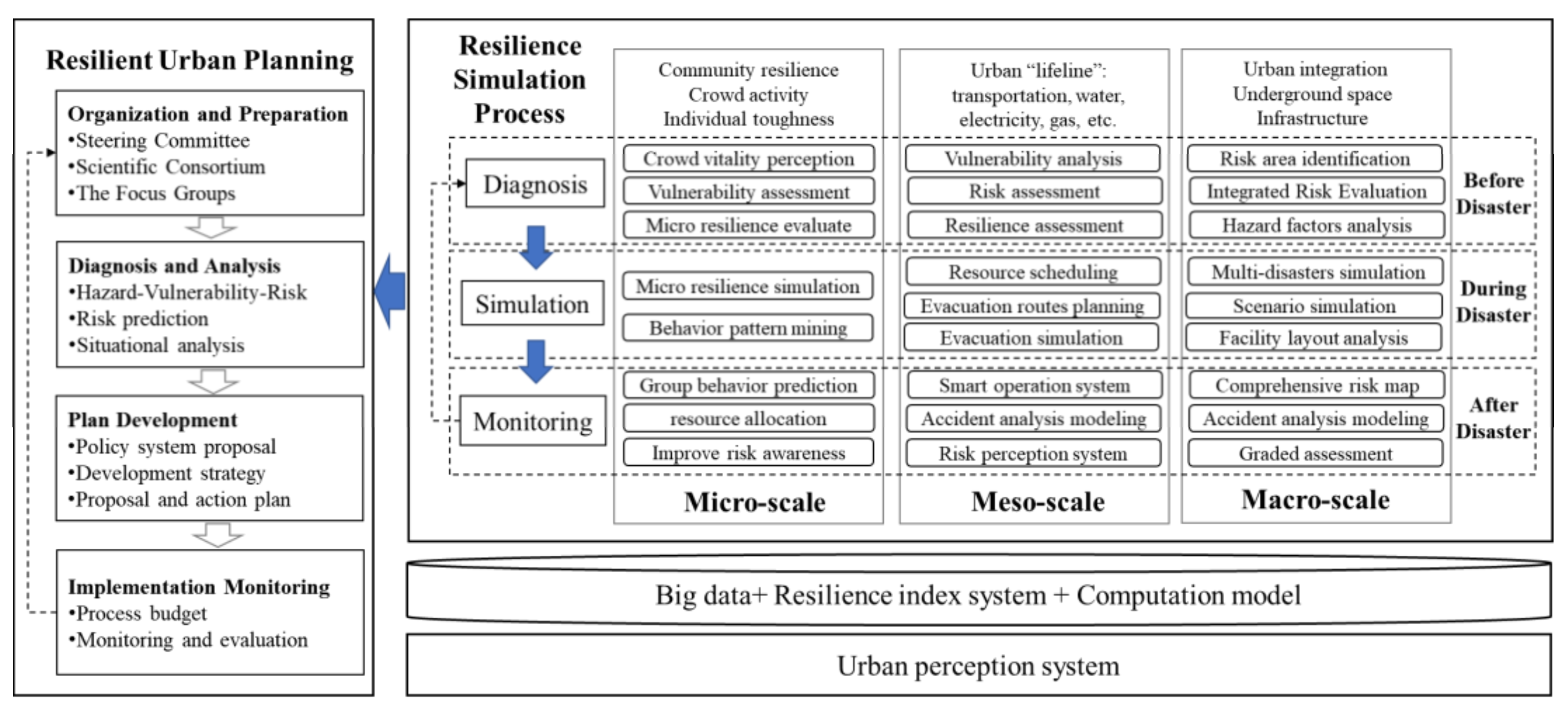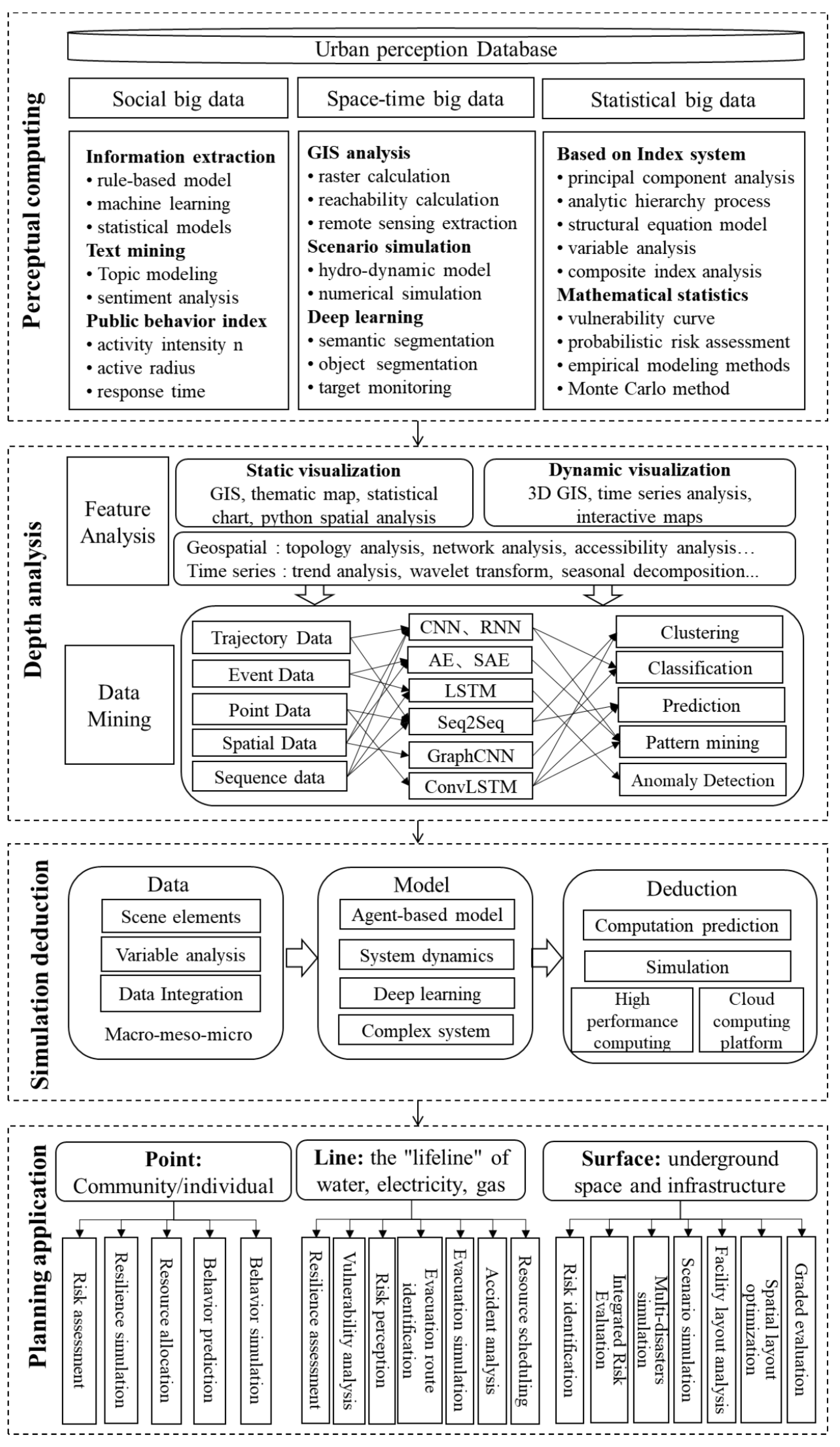Research Progress and Framework Construction of Urban Resilience Computational Simulation
Abstract
1. Introduction
2. Definition of Urban-Resilience Computation Simulation
3. Research Progress of Urban-Resilience Computation Simulation
3.1. “Soft”-Resilience Computation Simulation
3.1.1. Mathematical-Statistics Method
3.1.2. Social Big-Data Technology
3.1.3. Dynamic-Modeling Method
3.2. “Hard”-Resilience Computation Simulation
3.2.1. Ecological-Resilience Evolution
3.2.2. Risk-Assessment and Vulnerability Analysis
3.2.3. Infrastructure-Resilience Simulation
3.3. Comprehensive-Resilience Computation Simulation
3.3.1. Mathematical-Statistics and Spatial-Analysis Methods
3.3.2. Dynamic-Modeling Method
3.4. Summary
- (1)
- Multiple-risk disturbance scenarios are a potential area for improvement in resilience-computation simulation. Urban resilience should not only focus on the impact of single natural or man-made disasters, but also consider the coupling effect between various risk disturbances [88]. Existing studies mostly concerned single disturbance (e.g., flood, earthquake, and typhoon). More computational simulation should consider the multiple-hazard disaster scenario. In addition to exploring the evolutionary dynamic mechanism of resilience under various risks, future research should also simulate the dynamic interaction between multi-risks and the influencing mechanism of multi-risk on urban resilience.
- (2)
- There is a growing need for computational simulation of urban resilience based on human-centric information. Leveraging large-scale emerging data such as mobile phone-location data, social-media data, and public travel data, individual behaviors can be ”quantified” as group wisdom by mining people’s response patterns (e.g., the spatial–temporal pattern, semantic topics, and travel change) under a risk event [89]. These findings can provide new insights for the analysis, evaluation, decision-making, and planning management of urban resilience. In order to characterize, evaluate, and predict urban resilience, existing studies mostly used statistical models to mine public behavior patterns to certain disaster events in a short time from one dimension (e.g., temporal, spatial, or semantic). In the future, urban computing and data-driven methods can be combined to strengthen the innovative research of urban-resilience computation simulation from the perspective of multiple disturbances, long time series, and multiple dimensions.
- (3)
- The research on the urban-resilience computation-simulation framework with the goal of revealing the mechanism is still insufficient. The existing resilience framework still revolves around resilience-characteristics analysis, resilience assessment, and simulation of resilience evolution under various scenarios, orienting to a single dimension (e.g., ecology, society, or infrastructure). There is a lack of systematic research on the resilience-function mechanism, effect mechanism, and dynamic developing process. Future studies should consider the combination of artificial intelligence, urban computing, complex systems, and spatial-visualization technologies to establish an urban-resilience computation-simulation framework that can reveal the complex relationship between urban resilience and urban structural elements, and explore a multi-level, multi perspective, and multi-dimensional dynamic urban-resilience mechanism.
4. Computation-Simulation Framework for Resilient Urban Planning
4.1. Architecture Design
4.2. Computation-Simulation Framework
5. Conclusions
Author Contributions
Funding
Institutional Review Board Statement
Informed Consent Statement
Data Availability Statement
Conflicts of Interest
References
- Ernstson, H.; van der Leeuw, S.E.; Redman, C.L.; Meffert, D.J.; Davis, G.; Alfsen, C.; Elmqvist, T. Urban transitions: On urban resilience and human-dominated ecosystems. Ambio 2010, 39, 531–545. [Google Scholar] [CrossRef]
- Meerow, S.; Newell, J.P.; Stults, M. Defining urban resilience: A review. Landsc. Urban Plan. 2016, 147, 38–49. [Google Scholar] [CrossRef]
- Zhai, G.; Xia, C. Strategic Emphasis on the Construction of Resilient Cities in China. City Plan. Rev. 2021, 45, 44–48. (In Chinese) [Google Scholar]
- Holling, C.S. Resilience and Stability of Ecological Systems. Annu. Rev. Ecol. Syst. 1973, 4, 1–23. [Google Scholar] [CrossRef]
- Masnavi, M.R.; Gharai, F.; Hajibandeh, M. Exploring urban resilience thinking for its application in urban planning: A review of literature. Int. J. Environ. Sci. Technol. 2018, 16, 567–582. [Google Scholar] [CrossRef]
- Zhao, R.; Fang, C.; Liu, H. Progress and prospect of urban resilience research. Prog. Geogr. 2020, 39, 1717–1731. (In Chinese) [Google Scholar] [CrossRef]
- Yang, X.-P.; Wang, L.-K.; Li, Y.-B. Review and Prospects of Resilient City Theory. Geogr. Geoinf. Sci. 2021, 37, 78–84. (In Chinese) [Google Scholar]
- Wei, Y.; Xiu, C. Study on the concept and analytical framework of city network resilience. Prog. Geogr. 2020, 39, 488–502. (In Chinese) [Google Scholar] [CrossRef]
- Woodruff, S.; Bowman, A.; Hannibal, B.; Sansom, G.; Portney, K. Urban resilience: Analyzing the policies of U.S. cities. Cities 2021, 115, 103239. [Google Scholar] [CrossRef]
- Xiu, C.; Mei, D.; Bai, L.; Feng, X.; Wei, Y. A comprehensive assessment of urban resilience and its spatial differentiation in China. World Reg. Stud. 2019, 28, 77–87. (In Chinese) [Google Scholar]
- Melendez, A.; Caballero-Russi, D.; Gutierrez Soto, M.; Giraldo, L.F. Computational models of community resilience. Nat. Hazards 2021, 111, 1121–1151. [Google Scholar] [CrossRef]
- Tongyue, L. New Progress in Study on Resilient Cities. Urban Plan. Int. 2017, 32, 15–25. (In Chinese) [Google Scholar]
- Zang, X.; Wang, Q. The evolution of the urban resilience concept, and its research contents and development trend. Sci. Technol. Rev. 2019, 37, 94–104. (In Chinese) [Google Scholar]
- Bansal, N.; Mukherjee, M.; Gairola, A. Smart Cities and Disaster Resilience. In From Poverty, Inequality to Smart City; Springer: Singapore, 2017; pp. 109–122. [Google Scholar]
- Oke, A.E.; Aghimien, D.O.; Akinradewo, O.I.; Aigbavboa, C.O. Improving resilience of cities through smart city drivers. Constr. Econ. Build. 2020, 20, 45–64. [Google Scholar] [CrossRef]
- Sharifi, A. Urban form resilience: A meso-scale analysis. Cities 2019, 93, 238–252. [Google Scholar] [CrossRef]
- Palmieri, F.; Ficco, M.; Pardi, S.; Castiglione, A. A cloud-based architecture for emergency management and first responders localization in smart city environments. Comput. Electr. Eng. 2016, 56, 810–830. [Google Scholar] [CrossRef]
- Yao, F.; Wang, Y. Towards resilient and smart cities: A real-time urban analytical and geo-visual system for social media streaming data. Sustain. Cities Soc. 2020, 63, 102448. [Google Scholar] [CrossRef]
- DesRoches, R.; Taylor, J. The promise of smart and resilient cities. Bridge 2018, 48, 2. [Google Scholar]
- Kontokosta, C.E.; Malik, A. The Resilience to Emergencies and Disasters Index: Applying big data to benchmark and validate neighborhood resilience capacity. Sustain. Cities Soc. 2018, 36, 272–285. [Google Scholar] [CrossRef]
- Rus, K.; Kilar, V.; Koren, D. Resilience assessment of complex urban systems to natural disasters: A new literature review. Int. J. Disaster Risk Reduct. 2018, 31, 311–330. [Google Scholar] [CrossRef]
- Chen, Z.; Qiu, B.; Chen, H. Research on Resiliency Level Promotion and Robustness Strategy of Resilient City System: From Complex Adaptive Systems (CAS) Perspective. Urban Dev. Stud. 2021, 28, 1–9. (In Chinese) [Google Scholar]
- Ribeiro, P.J.G.; Pena Jardim Gonçalves, L.A. Urban resilience: A conceptual framework. Sustain. Cities Soc. 2019, 50, 101625. [Google Scholar] [CrossRef]
- Baoxing, Q. Methods and Principles of Designing Resilient City Based on Complex Adaptive System Theory. Urban Dev. Stud. 2018, 25, 1–3. (In Chinese) [Google Scholar]
- Zhang, X.X.D.; Wang, L. Model Architecture and Urban Computing for Parallel Cities Based on Complex Adaptive Systems. J. Command. Control. 2021, 7, 28–37. (In Chinese) [Google Scholar]
- Liu, Y. Urban Resilience System Development Measurement: Based on an Empirical Study of 288 Chinese Cities. Urban Dev. Stud. 2021, 28, 93–100. [Google Scholar]
- Coaffee, J.; Therrien, M.C.; Chelleri, L.; Henstra, D.; Aldrich, D.P.; Mitchell, C.L.; Tsenkova, S.; Rigaud, É. Urban resilience implementation: A policy challenge and research agenda for the 21st century. J. Contingencies Crisis Manag. 2018, 26, 403–410. [Google Scholar] [CrossRef]
- Moghadas, M.; Asadzadeh, A.; Vafeidis, A.; Fekete, A.; Kötter, T. A multi-criteria approach for assessing urban flood resilience in Tehran, Iran. Int. J. Disaster Risk Reduct. 2019, 35, 101069. [Google Scholar] [CrossRef]
- Scherzer, S.; Lujala, P.; Rød, J.K. A community resilience index for Norway: An adaptation of the Baseline Resilience Indicators for Communities (BRIC). Int. J. Disaster Risk Reduct. 2019, 36, 101107. [Google Scholar] [CrossRef]
- Eakin, H.; Bojórquez-Tapia, L.A.; Janssen, M.A.; Georgescu, M.; Manuel-Navarrete, D.; Vivoni, E.R.; Escalante, A.E.; Baeza-Castro, A.; Mazari-Hiriart, M.; Lerner, A.M. Opinion: Urban resilience efforts must consider social and political forces. Proc. Natl. Acad. Sci. USA 2017, 114, 186–189. [Google Scholar] [CrossRef]
- Lyu, Y.-F.; Xiang, M.-T.; Wang, M.-J.; Wu, C.-F. From disaster prevention to resilience construction: Exploration and prospect of resilience planning under the back-ground of territorial governance. J. Nat. Resour. 2021, 36, 2281–2293. (In Chinese) [Google Scholar] [CrossRef]
- Forrest, S.A.; Trell, E.-M.; Woltjer, J. Socio-spatial inequalities in flood resilience: Rainfall flooding in the city of Arnhem. Cities 2020, 105, 102843. [Google Scholar] [CrossRef]
- Nejat, A.; Javid, R.J.; Ghosh, S.; Moradi, S. A spatially explicit model of postdisaster housing recovery. Comput. Aided Civ. Infrastruct. Eng. 2019, 35, 150–161. [Google Scholar] [CrossRef]
- Heinzlef, C.; Robert, B.; Hémond, Y.; Serre, D. Operating urban resilience strategies to face climate change and associated risks: Some advances from theory to application in Canada and France. Cities 2020, 104, 102762. [Google Scholar] [CrossRef]
- Podesta, C.; Coleman, N.; Esmalian, A.; Yuan, F.; Mostafavi, A. Quantifying community resilience based on fluctuations in visits to points-of-interest derived from digital trace data. J. R Soc. Interface 2021, 18, 20210158. [Google Scholar] [CrossRef]
- Zhang, C.; Yao, W.; Yang, Y.; Huang, R.; Mostafavi, A. Semiautomated social media analytics for sensing societal impacts due to community disruptions during disasters. Comput. Aided Civ. Infrastruct. Eng. 2020, 35, 1331–1348. [Google Scholar] [CrossRef]
- Li, Q.; Tang, Z.; Coleman, N.; Mostafavi, A. Detecting early-warning signals in time series of visits to points of interest to examine population response to COVID-19 pandemic. IEEE Access 2021, 9, 27189–27200. [Google Scholar] [CrossRef]
- Laun, A.W. Data Architecture to Quantify and Characterize the Resilience of a Natural Disaster-Affected System. Doctoral dissertation, The George Washington University, Washington, DC, USA, 2022. [Google Scholar]
- Kryvasheyeu, Y.; Chen, H.; Obradovich, N.; Moro, E.; Van Hentenryck, P.; Fowler, J.; Cebrian, M. Rapid assessment of disaster damage using social media activity. Sci. Adv. 2016, 2, e1500779. [Google Scholar] [CrossRef]
- Wang, B.; Loo, B.P.Y.; Zhen, F.; Xi, G. Urban resilience from the lens of social media data: Responses to urban flooding in Nanjing, China. Cities 2020, 106, 102884. [Google Scholar] [CrossRef]
- Hong, B.; Bonczak, B.J.; Gupta, A.; Kontokosta, C.E. Measuring inequality in community resilience to natural disasters using large-scale mobility data. Nat. Commun. 2021, 12, 1870. [Google Scholar] [CrossRef]
- Chen, Z.; Gong, Z.; Yang, S.; Ma, Q.; Kan, C. Impact of extreme weather events on urban human flow: A perspective from location-based service data. Comput. Env. Urban Syst. 2020, 83, 101520. [Google Scholar] [CrossRef]
- Honghu, S. Evaluation of Urban Haze Disaster Resilience from the Perspective of Residents’ Activity: A Case Study of the Main Urban Area of Nanjing City. Sci. Geogr. Sin. 2019, 39, 788–796. (In Chinese) [Google Scholar]
- Taberna, A.; Filatova, T.; Roy, D.; Noll, B. Tracing resilience, social dynamics and behavioral change: A review of agent-based flood risk models. Socio-Environ. Syst. Model. 2020, 2, 17938. [Google Scholar] [CrossRef]
- Links, J.M.; Schwartz, B.S.; Lin, S.; Kanarek, N.; Mitrani-Reiser, J.; Sell, T.K.; Watson, C.R.; Ward, D.; Slemp, C.; Burhans, R. COPEWELL: A conceptual framework and system dynamics model for predicting community functioning and resilience after disasters. Disaster Med. Public Health Prep. 2018, 12, 127–137. [Google Scholar] [CrossRef]
- Gao, S.; Wang, Y. Assessing the impact of geo-targeted warning messages on residents’ evacuation decisions before a hurricane using agent-based modeling. Nat. Hazards 2021, 107, 123–146. [Google Scholar] [CrossRef]
- Grinberger, A.Y.; Felsenstein, D. Dynamic agent based simulation of welfare effects of urban disasters. Comput. Environ. Urban Syst. 2016, 59, 129–141. [Google Scholar] [CrossRef]
- Wang, P.; Li, Y.; Zhang, Y. An urban system perspective on urban flood resilience using SEM: Evidence from Nanjing city, China. Nat. Hazards 2021, 109, 2575–2599. [Google Scholar] [CrossRef]
- Xu, Y.; Li, G.; Cui, S. Review and Perspective on Resilience Science: From Ecological Theory to Urban Practice. Acta Ecol. Sin. 2018, 38, 5297–5304. (In Chinese) [Google Scholar]
- Hou, C.; Zhou, L.; Wen, Y. Evaluation of social-ecological systems resilience in ecological policy: A case study in Yanchi, Ningxia, China. China Popul. Resour. Environ. 2018, 28, 117–126. (In Chinese) [Google Scholar]
- Zhang, H.; Lliang, X.; Liu, D.; Shi, Q.; Hai, C. The resilience evolution and scenario simulation of social-ecological landscape in the fragile area. Acta Geogr. Sin. 2019, 74, 1450–1466. (In Chinese) [Google Scholar]
- Peng, L.; Xu, S.; Li, Z. Research on resilience improvement of urban communities based on multi-objective simulation. In Proceedings of the 2020 China Urban Planning Annual Conference, Chengdu, China, 25 September 2021; pp. 214–222. [Google Scholar]
- Feng, X.; Xiu, C.; Bai, L.; Zhong, Y.; Wei, Y. Comprehensive evaluation of urban resilience based on the perspective of landscape pattern: A case study of Shenyang city. Cities 2020, 104, 102722. [Google Scholar] [CrossRef]
- Salgado-Gálvez, M.A.; Zuloaga Romero, D.; Velásquez, C.A.; Carreño, M.L.; Cardona, O.-D.; Barbat, A.H. Urban seismic risk index for Medellín, Colombia, based on probabilistic loss and casualties estimations. Nat. Hazards 2016, 80, 1995–2021. [Google Scholar] [CrossRef]
- Bozza, A.; Asprone, D.; Parisi, F.; Manfredi, G. Alternative resilience indices for city ecosystems subjected to natural hazards. Comput. Aided Civ. Infrastruct. Eng. 2017, 32, 527–545. [Google Scholar] [CrossRef]
- Dong, S.; Esmalian, A.; Farahmand, H.; Mostafavi, A. An integrated physical-social analysis of disrupted access to critical facilities and community service-loss tolerance in urban flooding. Comput. Environ. Urban Syst. 2020, 80, 101443. [Google Scholar] [CrossRef]
- Kammouh, O.; Cimellaro, G.P.; Mahin, S.A. Downtime estimation and analysis of lifelines after an earthquake. Eng. Struct. 2018, 173, 393–403. [Google Scholar] [CrossRef]
- Dunn, S.; Wilkinson, S.; Alderson, D.; Fowler, H.; Galasso, C. Fragility curves for assessing the resilience of electricity networks constructed from an extensive fault database. Nat. Hazards Rev. 2018, 19, 04017019. [Google Scholar] [CrossRef]
- De Iuliis, M.; Kammouh, O.; Cimellaro, G.P.; Tesfamariam, S. Downtime estimation of building structures using fuzzy logic. Int. J. Disaster Risk Reduct. 2019, 34, 196–208. [Google Scholar] [CrossRef]
- De Iuliis, M.; Kammouh, O.; Cimellaro, G.P.; Tesfamariam, S. Quantifying restoration time of power and telecommunication lifelines after earthquakes using Bayesian belief network model. Reliab. Eng. Syst. Saf. 2021, 208, 107320. [Google Scholar] [CrossRef]
- Huang, W.; Ling, M. System resilience assessment method of urban lifeline system for GIS. Comput. Environ. Urban Syst. 2018, 71, 67–80. [Google Scholar] [CrossRef]
- Burger, A.; Oz, T.; Kennedy, W.G.; Crooks, A.T. Computational Social Science of Disasters: Opportunities and Challenges. Future Internet 2019, 11, 103. [Google Scholar] [CrossRef]
- Dresback, K.M.; Szpilka, C.M.; Xue, X.; Vergara, H.; Wang, N.; Kolar, R.L.; Xu, J.; Geoghegan, K.M. Steps towards Modeling Community Resilience under Climate Change: Hazard Model Development. J. Mar. Sci. Eng. 2019, 7, 225. [Google Scholar] [CrossRef]
- Ferdowsi, A.; Sanjab, A.; Saad, W.; Mandayam, N.B. Game Theory for Secure Critical Interdependent Gas-Power-Water Infrastructure; 2017 Resilience Week (RWS), 2017; IEEE: Piscataway, NJ, USA, 2017; pp. 184–190. [Google Scholar]
- Nateghi, R. Multi-dimensional infrastructure resilience modeling: An application to hurricane-prone electric power distribution systems. IEEE Access 2018, 6, 13478–13489. [Google Scholar] [CrossRef]
- Yan, W.; Lu, J.; Li, Z.; Shen, Y. Implications of Measuring Resilience of Urban Street Networks: Comparative Study of Five Global Cities. Urban Plan. Int. 2021, 36, 1–12+137. (In Chinese) [Google Scholar]
- Sun, L.; Stojadinovic, B.; Sansavini, G. Agent-Based Recovery Model for Seismic Resilience Evaluation of Electrified Communities. Risk Anal. 2019, 39, 1597–1614. [Google Scholar] [CrossRef]
- Marasco, S.; Cardoni, A.; Noori, A.Z.; Kammouh, O.; Domaneschi, M.; Cimellaro, G.P. Integrated platform to assess seismic resilience at the community level. Sustain. Cities Soc. 2021, 64, 102506. [Google Scholar] [CrossRef]
- Kasmalkar, I.G.; Serafin, K.A.; Miao, Y.; Bick, I.A.; Ortolano, L.; Ouyang, D.; Suckale, J. When floods hit the road: Resilience to flood-related traffic disruption in the San Francisco Bay Area and beyond. Sci. Adv. 2020, 6, eaba2423. [Google Scholar] [CrossRef]
- Wang, H.-W.; Peng, Z.-R.; Wang, D.; Meng, Y.; Wu, T.; Sun, W.; Lu, Q.-C. Evaluation and prediction of transportation resilience under extreme weather events: A diffusion graph convolutional approach. Transp. Res. Part C Emerg. Technol. 2020, 115, 102619. [Google Scholar] [CrossRef]
- Zhang, P.; Yu, W.; Zhang, T. Spatial-temporal differentiation and its influencing factors of Shandong Province’s urban resilience. Urban Probl. 2018, 9, 27–34. (In Chinese) [Google Scholar]
- Lu, L.; Zhou, H.; Xu, Q. Application research on comprehensive evaluation of urban resilience from the perspective of multidimensional relational networks. Urban Probl. 2020, 8, 42–55. (In Chinese) [Google Scholar]
- Chen, X.; Lou, J.; Wang, Y. Evolution and Dynamic Simulation of the Temporal-Spatial Pattern of Urban Resilience in Harbin-Changchun Urban Group. Sci. Geogr. Sin. 2020, 40, 2000–2009. (In Chinese) [Google Scholar]
- Liu, Z. Exploring Urban Resilience from a Social-EcologicalPerspective: A Case Study of the Central City of Shenyang. Ph.D. Dissertation, Northeast Normal University, Changchun, China, 2019. (In Chinese). [Google Scholar]
- Chen, C.; Chen, Y.; Shi, B.; Tong, X. A model for evaluating urban resilience to rainstorm flood disasters. China Saf. Sci. J. 2018, 28, 1–6. (In Chinese) [Google Scholar]
- Zhengzhao, L.I.; Dafang, F.U.; Junxian, W.A.; Kedong, M.I.; Junyu, Z.H. Urban resilience assessment model for waterlogging disasters and its applica-tion. J. Tsinghua Univ. 2022, 62, 266–276. (In Chinese) [Google Scholar]
- Shao, W.; Su, X.; Lu, J.; Liu, J.; Yang, Z.; Mei, C.; Liu, C.; Lu, J. Urban Resilience of Shenzhen City under Climate Change. Atmosphere 2021, 12, 537. [Google Scholar] [CrossRef]
- Gao, J.; Barzel, B.; Barabasi, A.L. Universal resilience patterns in complex networks. Nature 2016, 530, 307–312. [Google Scholar] [CrossRef]
- Roy, D.; Lees, M. Understanding resilience in slums using an agent-based model. Comput. Environ. Urban Syst. 2020, 80, 101458. [Google Scholar] [CrossRef]
- Shi, Y.; Zhai, G.; Zhou, S.; Lu, Y.; Chen, W.; Deng, J. How Can Cities Respond to Flood Disaster Risks under Multi-Scenario Simulation? A Case Study of Xiamen, China. Int. J. Environ. Res. Public Health 2019, 16, 618. [Google Scholar] [CrossRef]
- Datola, G.; Bottero, M.; De Angelis, E. How Urban Resilience Can Change Cities: A System Dynamics Model Approach. In Computational Science and Its Applications—ICCSA 2019; Springer: Cham, Switzerland, 2019; pp. 108–122. [Google Scholar]
- Li, G.; Kou, C.; Wen, F. The dynamic development process of urban resilience: From the perspective of interaction and feedback. Cities 2021, 114, 103206. [Google Scholar] [CrossRef]
- Chen, C.; Xu, L.; Zhao, D.; Xu, T.; Lei, P. A new model for describing the urban resilience considering adaptability, resistance and recovery. Saf. Sci. 2020, 128, 104756. [Google Scholar] [CrossRef]
- Feofilovs, M.; Romagnoli, F. Dynamic assessment of urban resilience to natural hazards. Int. J. Disaster Risk Reduct. 2021, 62, 102328. [Google Scholar]
- Huang, J.; She, J.; Yuan, X. Simulation of Urban Flood Resilience Based on A System Dynamic Model: A Case Study in Nanjing. Resour. Environ. Yangtze Basin 2020, 29, 2519–2529. (In Chinese) [Google Scholar]
- Li, R. Research of high-precision risk simulation of urban flooding and resilience optimization strategy. Master dissertation, East China Normal University, Shanghai, China, 2019. (In Chinese). [Google Scholar]
- Ba, R.; Deng, Q.; Liu, Y.; Yang, R.; Zhang, H. Multi-hazard disaster scenario method and emergency management for urban resilience by integrating experiment–simulation–field data. J. Saf. Sci. Resil. 2021, 2, 77–89. [Google Scholar]
- Tong, P. Characteristics, dimensions and methods of current assessment for urban resilience to climate-related disasters: A systematic review of the literature. Int. J. Disaster Risk Reduct. 2021, 60, 102276. [Google Scholar] [CrossRef]
- Zhang, S.; Zhen, F.; Qin, X.; Tang, J. The conceptual model and technical framework of participatory sensing and computing for urban community planning. Geogr. Res. 2020, 39, 1580–1591. (In Chinese) [Google Scholar]
- Zayas, J.; Bendimerad, F. Urban Resilience Master Planning: A Guidebook for Practitioners and Policymakers; Earthquakes and Megacities Initiative, Inc.: Quezon City, Philippines, 2015. [Google Scholar]
- Rogov, M.; Rozenblat, C. Urban Resilience Discourse Analysis: Towards a Multi-Level Approach to Cities. Sustainability 2018, 10, 4431. [Google Scholar] [CrossRef]




| Most Studies | Some Studies | A Few Studies | |
|---|---|---|---|
| Space–time scale | A single scale: country-level, region-level, and city-level scales | A single scale: city level and community level | Multi-scale: integration of macro, medium, and micro scales |
| Risk types | Disaster event: floods, earthquakes, hurricanes, typhoons, etc. | Urban disturbances: climate change, urban growth, environment change, etc. | Multidimensional scenario: multi-disaster coupling, multi-risk scenarios |
| Data indicators | Traditional statistical data using questionnaires, expert scoring methods, etc. | Geographic data, remote-sensing data and monitoring data using professional models | Multi-source data: large-scale mobility data, social media, street-view images and POI, etc. |
| Methods | Mathematical statistics: SEM, AHP, PRA, etc. Spatial analysis: geographical detectors, spatial statistical analysis, etc. | Dynamic modeling methods: agent-based modeling, system-dynamics model, game theory, complex network model, etc. | Other methods: semantic analysis, sentiment analysis, convolutional neural network (CNN), etc. |
Publisher’s Note: MDPI stays neutral with regard to jurisdictional claims in published maps and institutional affiliations. |
© 2022 by the authors. Licensee MDPI, Basel, Switzerland. This article is an open access article distributed under the terms and conditions of the Creative Commons Attribution (CC BY) license (https://creativecommons.org/licenses/by/4.0/).
Share and Cite
Han, X.; Wang, L.; Xu, D.; Wei, H.; Zhang, X.; Zhang, X. Research Progress and Framework Construction of Urban Resilience Computational Simulation. Sustainability 2022, 14, 11929. https://doi.org/10.3390/su141911929
Han X, Wang L, Xu D, Wei H, Zhang X, Zhang X. Research Progress and Framework Construction of Urban Resilience Computational Simulation. Sustainability. 2022; 14(19):11929. https://doi.org/10.3390/su141911929
Chicago/Turabian StyleHan, Xuehua, Liang Wang, Dandan Xu, He Wei, Xinghua Zhang, and Xiaodong Zhang. 2022. "Research Progress and Framework Construction of Urban Resilience Computational Simulation" Sustainability 14, no. 19: 11929. https://doi.org/10.3390/su141911929
APA StyleHan, X., Wang, L., Xu, D., Wei, H., Zhang, X., & Zhang, X. (2022). Research Progress and Framework Construction of Urban Resilience Computational Simulation. Sustainability, 14(19), 11929. https://doi.org/10.3390/su141911929






